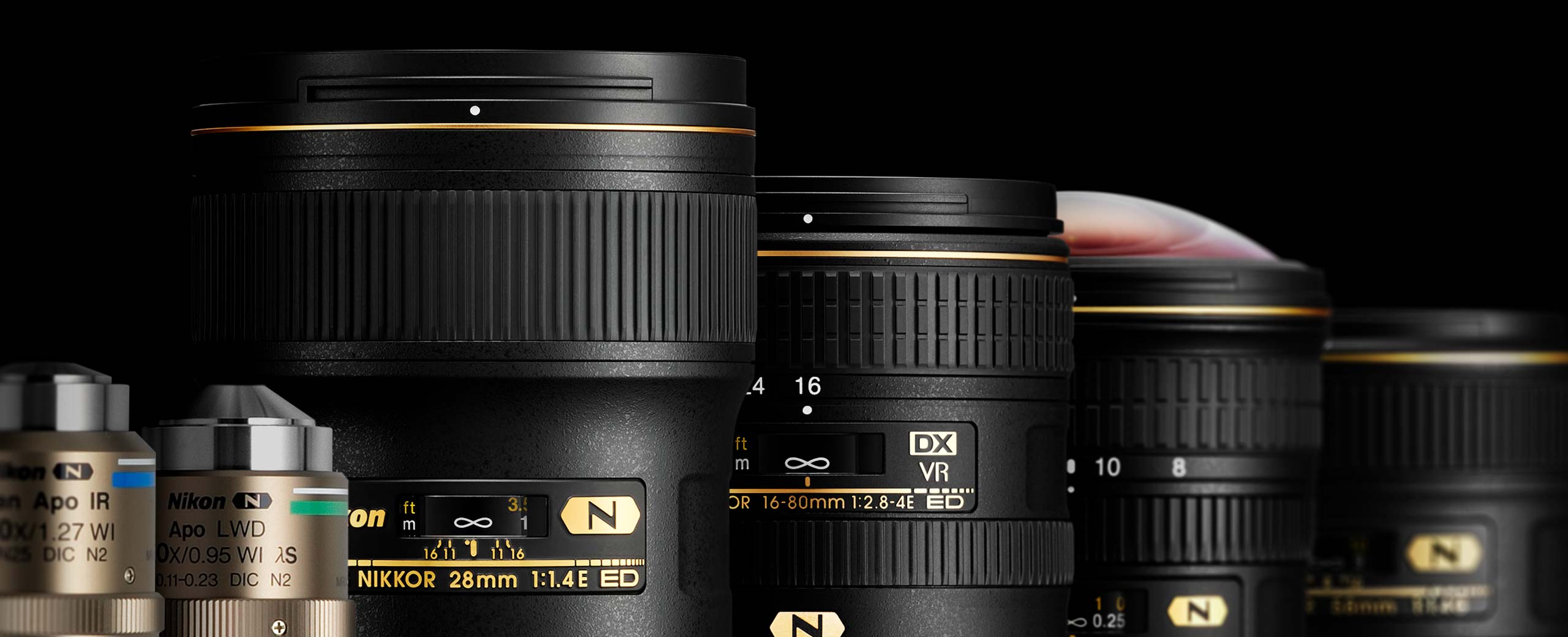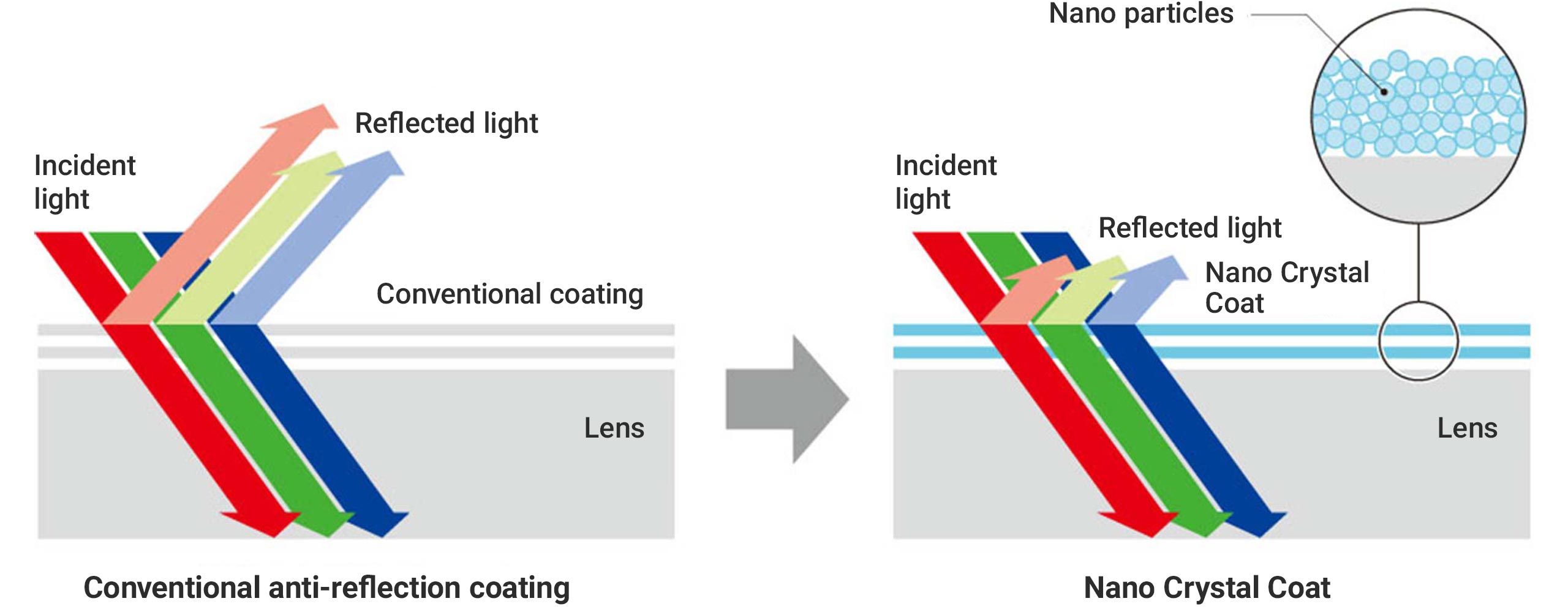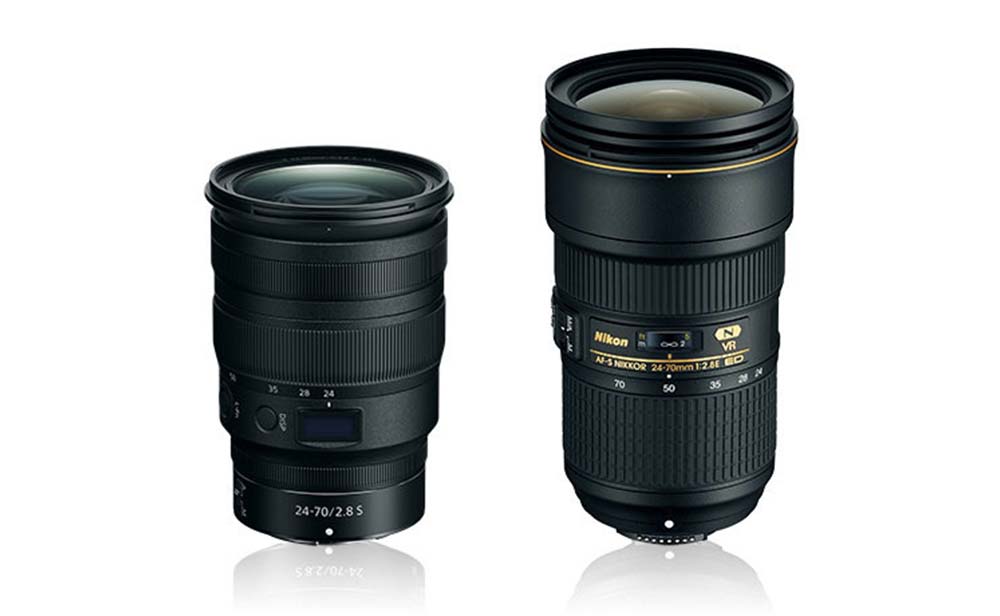
Nano Crystal Coat puts innovation right before your eyes
If light is reflected inside a camera lens, it produces the problems of ghost and flare.
When these phenomena occur unintentionally, they can undermine the desired effect of an image.
Reducing these incidences of reflection could not be achieved by conventional means, which is why Nikon developed its Nano Crystal Coat. This technology drastically reduces ghost and flare by employing technological innovations originally developed for the projection lenses utilized in Nikon's semiconductor lithography systems.
In this way, Nikon puts advanced technologies to effective use in a wide range of products.
Effective against persistent types of ghost and flare
Imagine a lens that could transmit light perfectly without reflecting any at all. Such a lens would be ideal, but to date it simply doesn't exist. Whatever material is used and regardless of how well polished, some percentage of light will always be reflected.
If light is reflected within a camera lens, it appears in the image as ghost (circles, spheres or striations) or flare (the image has blown out highlights). When these reflections are unintended, they can ruin your photos. As a result, camera lenses are coated to prevent such problems.


(*This image is processed for comparison)
It used to be accepted wisdom that, no matter how good a coating technology might be, ghost and flare produced by strong light entering a lens at an oblique angle could not be reduced significantly. However, this difficult problem was actually solved by using anti-reflection coating, called Nano Crystal Coat. Nikon has coatings that perform various functions, and Nano Crystal Coat is specially designed for anti-reflection.
Reflections occur when light travels through one medium (such as air) then enters another material (such as glass). The higher the difference in the refractive indexes of the substances, the more light is reflected. With this in mind, Nano Crystal Coat that consists of nanometer-sized* particles is applied to the surface of a lens. This reduces the difference in refractive index between the glass and air by creating a structure that has spaces between one particle and another. It cuts the refractive index disparity by a greater degree than conventional coatings ever could, and greatly reduces the types of flare and ghost that could not previously be suppressed.
- *A nanometer is equal to one billionth of a meter.

Inspired by innovations in semiconductor lithography systems

The origin of this groundbreaking technology is a coating technology developed for the projection lenses of semiconductor lithography systems.
In order to meet the high performance required for semiconductor lithography, a projection lens demands very high resolution whereby approximately 10,000 lines could be drawn on a cross section of human hair (average thickness of 0.08 to 0.05 nm. It also requires a lens that can effectively handle light entering at an oblique angle. However, conventional coating technologies could not suppress that kind of light.
Nikon utilized nanotechnology to solve this problem and succeeded in creating a nanoparticle film, which was developed into an innovative anti-reflective film.
Semiconductor lithography systems use ultraviolet light. However, the structure of the nanoparticle film was also found to have an anti-reflective effect in the visible range. The developer of the film mentioned this information in passing to an engineer in the camera division, which led to the technology beginning its transfer to that division for use with camera lenses.
However, engineers encountered a huge obstacle in the form of mass production. Unlike lenses for semiconductor lithography systems, camera lenses have to be mass-produced. Due to the Nano Crystal Coat's delicate structure, the assembly process required more careful handling than ever before. This difficulty was overcome by applying the production technology cultivated for projection lenses in synergy with the production technology for camera lenses. Since then, Nano Crystal Coat has been applied to a variety of high-performance lenses, starting with the AF-S VR Nikkor 300mm f/2.8G IF-ED.
The technology expands into objective lenses for microscopes

The high degree of success enjoyed by camera lenses employing Nano Crystal Coat inspired the developers of objective lenses for microscopes. Lenses that require light from an oblique angle allow observation of a subject with a brighter view, which made the coating sought-after in this new field as well.
Nano Crystal Coat technology was applied to microscope lenses. The result was objective lenses with excellent light transmission across a wide range, from ultraviolet to infrared.
Using nanotechnology, the Nano Crystal Coat eliminates reflections which are obstacles to imaging and resolution by reducing the difference in refractive index with air. It originated in projection lenses for semiconductor lithography systems, and was then applied to camera lenses, which are so familiar in our everyday lives and subsequently to microscope lenses that contribute to life sciences. In the future, Nikon plans to continue to support the advancing performance of NIKKOR lenses while expanding into various other fields, such as optical component products.
"I want to be the go-to guy for coatings"
Production Technology Division
Takeshi Shirai

Since joining the company, I have been deeply involved in developing lens coating technologies, as well as in employing coatings for a variety of lenses. Products that utilize Nano Crystal Coat tend to be expensive, but I am confident that the value of this technology completely justifies its price. I feel that camera lenses with the Nano Crystal Coat provide a genuine sense of high performance, including other aspects of optical performance.
I have been involved for a long time in developing thin-film technologies for semiconductor lithography systems and for camera lenses as well, but when a technology that I've been involved with is adopted for an everyday product, such as camera lenses, then I really feel the joy of being an engineer. This is all the more true when it's a technology you care deeply about.
The development of coatings requires an extremely wide range of knowledge — chemistry, naturally, but also physics, electrical knowhow, metrology, software, etc. Building upon this broad base, I aim to develop technologies that do not exist yet, such as coatings that offer both super-hard strength and excellent optical performance. I am going to continue working to the best of my abilities so that more and more people in-house will rely on me as the "go-to guy for coatings." At the same time, I will focus on related human resource development.
- *Job title and responsibilities are as of the time of the interview.
Originally published: February 27, 2020.

Stories
- The future of "oshikatsu" through imaging technology
- Innovating the workstyle of the livestock industry through DX
- The further development of society through semiconductors
- Rewriting the rulebook for professional cameras — A story of still shooting with the Z 9
- Pushing the limits of the photojournalism frontline — Part 2
- Pushing the limits of the photojournalism frontline — Part 1
- Manufacturing with light
- Manufacturing glass that grows like a lifeform
- Nano Crystal Coat puts innovation right before your eyes
- The compact mirrorless Z 50 packs mighty technologies
- Advancing Monodzukuri (manufacturing) through synergetic innovation
- Analyzing NIKKOR lens characteristics
- Manufacturing on a giant scale with extreme precision
- Contributing to food safety and security
- Ultimate resolution supported by movements as slight as 2/100,000,000,000 of a meter
- Revealing the mysteries of the brain
- Supporting manufacturing through highly precise, non-destructive inspection
- Next-level performance through posture analysis
- In the future, robots will work alongside you
- The future inspired by the possibilities of FPDs
- Key to practical application of regenerative medicine
- Investigating the Future of Earth from Venus



